ShodhKosh: Journal of Visual and Performing ArtsISSN (Online): 2582-7472
|
|
THE ARTISTRY OF MIRROR EMBELLISHMENTS IN FASHION
Jahnavi Rayalwar
1![]()
![]() ,
E Mokanaasri 2
,
E Mokanaasri 2![]()
![]()
1 Bachelor
Student, School of Arts and Design, Woxsen
University, Hyderabad, Telangana, India
2 Research
Scholar, School of Arts and Design, Woxsen
University, Hyderabad, Telangana, India
|
|
ABSTRACT |
||
|
Mirror work is
a traditional textile embellishment technique that involves stitching small
pieces of reflective material, often mirrors, onto fabric. This intricate
craft has been used for centuries to adorn garments, particularly in Indian
culture, where it is believed to ward off evil and bring good luck. This
style combines traditional craftsmanship with modern manufacturing methods,
producing high-quality, market-ready products. Digital design techniques have
streamlined the process, enabling precise and repeated patterns that enhance
the visual appeal. This fusion of traditional craftsmanship with contemporary
technology exemplifies the potential for innovation in the textile industry.
This study explores the historical significance, Global Designers and
Innovation in mirror work, various types of mirror work, techniques,
variations used in the fashion fields, and different methods of attaching
mirrors to fabric, including frames for the mirror. This study also discusses
the applications of mirror work in fashion, highlighting its use in
traditional and trendy garments. The fusion of mirror works into textile
designs, informed by extensive secondary data, has led to the development of
innovative and aesthetically pleasing products. |
|||
|
Received 25 June 2024 Accepted 24 July 2024 Published 30 July 2024 Corresponding Author E Mokanaasri, mokanaadevreddy.98@gmail.com
DOI 10.29121/shodhkosh.v5.i2.2024.1494 Funding: This research
received no specific grant from any funding agency in the public, commercial,
or not-for-profit sectors. Copyright: © 2024 The
Author(s). This work is licensed under a Creative Commons
Attribution 4.0 International License. With the
license CC-BY, authors retain the copyright, allowing anyone to download,
reuse, re-print, modify, distribute, and/or copy their contribution. The work
must be properly attributed to its author.
|
|||
|
Keywords: Mirror Work, Traditional Craftsmanship, Digital
Design Techniques, Innovative Designs, Textile Embellishments |
|||
1. INTRODUCTION
Mirror work, or
shisha or abhala bharat
embroidery, is a unique form of hand needlework. It involves the meticulous
sewing of tiny mirror bits onto fabric. This art form originated in Persia and
was introduced to India during the Mughal Empire in the 13th century. It was
not just a decorative technique but a cultural
practice aimed at warding off bad luck and protecting the wearer from the evil
eye Chopra (2019).
The artisans of
the Jat group, hailing from Gujarat's Kutch district, brought with them a rich
heritage of traditional embroidery and mirror work when they migrated from Balochistan in the 17th century. This migration marked a
significant turning point in the popularity of mirror work in India. With their
deep appreciation for the craft, the states of Gujarat, Rajasthan, and Haryana
became significant markets for mirror work, further fueling
its popularity Fashion (2024).
Mirror work is an
intriguing fashion embellishment because of its inherent properties. A
captivating array of colour and light is produced by the mirrors' reflection
and absorption of light. Every piece of clothing has a magical touch as the
wearer moves around and causes the mirrors to glitter and dance. Mirror work is
a timeless heritage in worldwide fashion because of its ability to bring glitz
and brilliance Mirror Work on Fabrics – 10
Simple Embroidery Designs you Could use. (2022).
This study is
limited by two primary factors: secondary data and the techniques for
incorporating traditional mirror work into contemporary fashion. The secondary
data includes various types and variations of mirror work and its cultural
background, making it challenging to understand and adapt it to modern trends
fully. Additionally, design development was used to assess the garment's output
visually. Modern textiles may not be suitable for traditional processes due to
their weight, drape, and movement. They involve creative solutions to merge
historical techniques with contemporary aesthetics.
The research gap identified in this paper need for
comprehensive documentation on the traditional techniques, patterns, and
regional variations of mirror work embroidery and also
technical aspects
of incorporating mirrored materials into fashion design.
Conducted detailed studies and recordings of these elements is essential to
preserving this heritage for future generations.
Figure 1

|
Figure 1 Mirror Work in Fashion Source Chopra (2019) |
2. REVIEW LITERATURE
2.1. Historical significance of mirror work
embroidery
Mirror work
embroidery, or "shisha" embroidery, originates in 13th-century
Persia. This intricate craft involves using tiny mirrors to create elaborate
and reflective designs on fabric. The technique spread to India during the
Mughal era, and it was brought by travellers and traders who introduced it to
the Indian subcontinent. The Mughals, known for their rich cultural
contributions, adopted and refined this craft, integrating it into their
textile traditions. Over time, mirror work became particularly popular in the
western regions of India, such as Gujarat and Rajasthan, where local artisans
embraced and further developed it. The vibrant and colourful nature of Indian
textiles provided a perfect canvas for mirror work, allowing it to flourish and
become an integral part of traditional Indian embroidery. Mirror work remains a
celebrated and widely practiced art form, blending historical techniques with
contemporary designs Chopra (2019).
2.1.1.
Evolution of Mirror Work Embroidery in India
Each Indian
state and community has developed its unique styles of
mirror work embroidery, characterized by distinct motifs, colours, and shapes
inspired by nature. In Gujarat, for instance, the embroidery often features
intricate floral and animal patterns, while Rajasthan's mirror work incorporates
geometric designs and vibrant hues. The techniques used in mirror work have
evolved significantly over time. Initially, artisans used mica and hand-blown
glass mirrors, later replaced by machine-cut glass and reflective metal pieces,
allowing for more precise and varied designs. The process of attaching these
mirrors to fabric has also seen innovation. Traditional intricate cross-stitch
embroidery was used to secure the mirrors and enhance the overall aesthetic of
the garment. This detailed embroidery around the mirrors added depth and
richness to the designs, making each piece unique. These evolving techniques
have kept the craft dynamic, blending tradition with modernity. As a result,
mirror work embroidery continues to be a vibrant and essential part of India's
textile heritage, reflecting the diverse cultural expressions of its
communities Pedia (2017).
2.1.2. Global Designers and Innovations in Mirror Work Embroidery
Mirror work
embroidery has a rich history in India; Designers in India have played a key
role in reviving and modernizing this ancient craft. Designer duo Abu Jani and
Sandeep Khosla were among the first to bring mirror work to the couture
grandstand, using oversized square mirrors and gold threads to give it a fresh,
high-fashion expression Dangor (2019). Designers like Anita Dongre and
Anamika Khanna have also incorporated mirror work extensively in their
collections, working with hundreds of artisans to keep the craft alive Chopra (2019).
Contemporary
designers are experimenting with mirror work innovatively, blending it with
modern silhouettes, prints, and embroidery techniques. Designer Abhinav Mishra
uses mirror work to create deconstructed motifs with gota
and silk threads and prints. He has also applied mirror work to contemporary
choli designs with shoulder-baring, deep neck, and backless styles Chopra (2019).
Beyond
fashion, mirror work is also used in interior design and architecture.
Designers are drawing inspiration from the mirrored rooms and domes of historic
Indian palaces to incorporate the craft into their work. This cross-pollination
of mirror work across different creative disciplines helps to further its
evolution and ensure its continued relevance.
Overall, the
timelessness and versatility of mirror work have made it a beloved craft that
designers are working hard to preserve and reinterpret for the modern era. By
blending traditional techniques with contemporary aesthetics, they ensure this
ancient Indian art form thrives.
2.2. Types of Mirror work
In
the art of mirror work, various techniques are employed to securely attach
mirrors to fabric while enhancing the overall aesthetic of the garment. These
methods ensure the mirrors' durability and add intricate decorative elements to
the design Hunar.
(2021). Some common types used in mirror work are shown in Figure 2.
Figure 2

|
Figure 2 Types of Mirror Work
Source Hunar. (2021) |
1) Framed Elegance: This technique demands your
meticulous attention and skill. It involves coiling embroidery thread around
the mirror's perimeter with utmost precision. The thread is then securely
stitched onto the fabric using various stitches, such as the chain or satin
stitch, creating a defined and polished border for the mirrored element. This
adds an extra layer of intricacy to the design, making you feel accomplished
with your craft.
2) The Star Stitch: This method is not just about attaching the mirror; it's
about adding a unique and beautiful decorative element. To achieve this, bring
the thread over the mirror and insert the needle into the fabric on the
opposite side of the mirror, creating a straight stitch across the mirror (Tiny
star-shaped stitches). This fastens the mirror to the fabric, lending a touch
of celestial charm to the design. This method inspires creativity and adds a
personal touch to your work.
3) Triangular Frame Stitches: This visually captivating approach is sure to catch the
eye. It utilizes a series of geometric triangles stitched meticulously around
the mirror. The base of each triangle is then securely sewn onto the fabric,
creating a structured frame for the mirrored element. This technique tempts
curiosity and makes you eager to try it out.
4) Anchor with Chain Stitch: This secure and versatile technique utilizes a series of
chain stitches to anchor the mirror to the fabric. This method is particularly
effective for attaching mirrors of various sizes, ensuring they remain firmly
affixed to the garment Corbet
& Corbet (2017).
2.3. Techniques and variations
Mirrorwork's
dazzling effect is a result of not just the technique but also the type of
mirrors used. Let's search for the fascinating world of mirror selection and
secure attachment methods.
Figure 3

|
Figure 3 Various Shapes of Mirror and
Techniques (Embroidery) Source Mirror Work on Fabrics – 10 Simple
Embroidery Designs you Could use. (2022), Corbet & Corbet (2017) |
1)
Size
of the mirror: Mirrors come in different sizes, ranging from small to
large, depending on the design and the fabric used.
2)
Material
Considerations: While traditional glass mirrors remain popular,
contemporary designers increasingly explore alternative materials for their
unique properties. Acrylic is lightweight for intricate embellishments, while
plastic allows for vibrant colour incorporation. With their inherent textures,
metal mirrors can add a touch of dimension and depth to a design.
3)
Shape
Dynamics: The size and shape of the mirrors employed can drastically
alter the overall aesthetic of the garment. Circular mirrors represent a
timeless classic, offering a sense of elegance and fluidity. On the other hand,
square mirrors exude a modern and structured feel. Using geometric shapes, such
as triangles or hexagons, injects a playful and contemporary edge into the
design Loom (2022).
4)
The
Art of Embroidery Techniques: The secure attachment of mirrors to the
fabric is paramount in creating a well-constructed and visually appealing
garment. Embroidery techniques like the straight stitch, blanket stitch, and
couching stitch provide robust and aesthetically pleasing methods for anchoring
the mirrors in place Mirror Work on Fabrics – 10
Simple Embroidery Designs you Could use. (2022).
2.4. Applications of mirror work in fashion
Figure 4

|
Figure 4 Applications
of Mirror Work in Fashion Source Hunar (2021), Dhrutikothari.
(2015), Soniya (2022) |
2.4.1. Embellishing Heritage
1) Cholis, Sarees, Lehengas, and Kurtis: Mirror work, a symbol of our rich South Asian heritage, is deeply ingrained in our traditional attire. Cholis (blouses), sarees (draped garments), lehengas (skirts), and Kurtis (tunics) are adorned with these dazzling embellishments, creating garments that are not just beautiful but also carry a profound cultural significance Dhrutikothari. (2015), Zoysacorrea. (2023).
2.4.2. Modern Interpretations
1) Contemporary Designs and Modern Silhouettes: Mirror work is not confined to traditional attire. Modern designers are pushing boundaries by incorporating this technique into contemporary silhouettes. Mirror work adorns dresses, gowns, jackets, and even pants, creating an exciting fusion of tradition and modernity Loom (2022).
2.4.3. Beyond Gender
1) Use in Menswear and Accessories: Traditionally associated with women's clothing, mirror work makes inroads into menswear. Embellished jackets, shirts, and shoes add unexpected glamour to men's fashion. Mirror work also finds its way onto accessories like bags, clutches, and belts, creating a cohesive and dazzling look The Significance of Mirror Work on Saree Belts. (2024).
2.5. Modernizing mirror work
1) Traditional Techniques with a Modern Twist: Skilled artisans stay within their time-tested skills. Instead, they are incorporating traditional mirror work techniques into contemporary styles. It can involve using mirrors in unconventional shapes or sizes or employing innovative embroidery methods to create unique textures and patterns Chopra (2019). Mirror work is blended with other embroidery techniques, such as chain stitch and herringbone stitch, to create intricate patterns Mirror Work on Fabrics – 10 Simple Embroidery Designs you Could use. (2022).
2) Deconstructed Dazzle: The deconstruction of traditional motifs is a prominent trend in contemporary fashion. Mirror work is no exception. Designers are experimenting with deconstructing the traditional placement of mirrors, creating fragmented patterns, or even using them as three-dimensional elements to add depth and intrigue to a garment Patel (2023).
3. METHODOLOGY
3.1. Research Design
This study adopted a secondary source approach to analyze existing literature and data on the use of mirror
work in professional fashion fields. This paper is divided into two phases:
Literature review and Design development, as shown in Figure 5
Figure 5
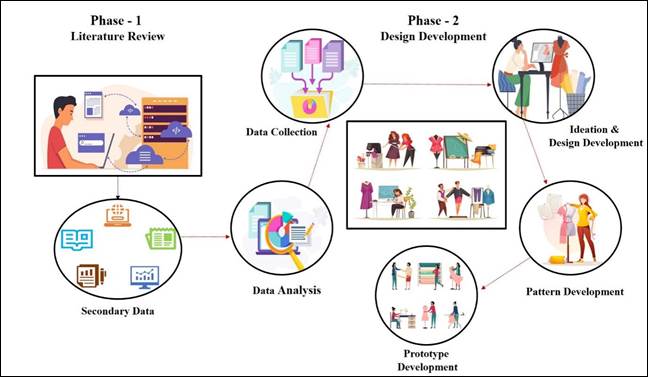
|
Figure 5 Process Flow of Methodology |
3.2. Phase 1: Literature review
This
study utilized a secondary source methodology to explore the historical and
cultural significance, types, techniques, variations, and applications of
mirror work in fashion. The research aims to comprehensively understand mirror
work's evolution and contemporary relevance by analyzing
existing literature, fashion magazines, academic journals, and multimedia
sources.
3.3. Phase 2: Design development
3.3.1. 3Analysis of Collected Data
Data from secondary sources were analyzed to identify standard designs and garment patterns
for mirror work. The design elements were then documented and categorized.
3.3.2. Ideation and Design Development
Based on the analysis of secondary data, traditional and contemporary design concepts were digitally created to visualize this concept. Additionally, a customized mirror design was developed. The colour palette for this study is inspired by the natural reflections of sunlight, blending traditional vibrant hues with modern metallics and pastels. This fusion enhances the reflective quality of the mirrors, creating a contemporary yet culturally rooted aesthetic. The result is a fresh, dynamic interpretation of traditional mirror work embroidery.
Figure 6
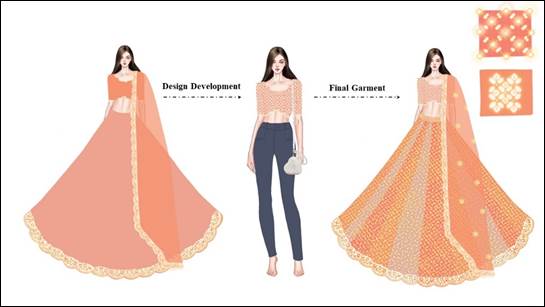
|
Figure 6 Digital Design Development - (Garment -1) |
Figure 7
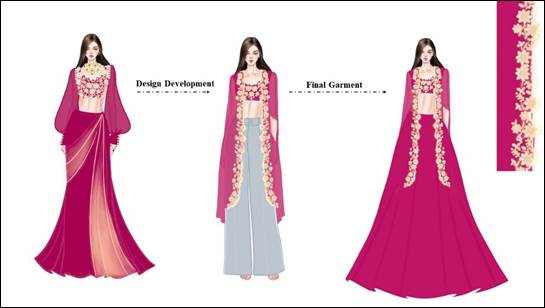
|
Figure 7 Digital Design Development – (Garment -2) |
Figure 8
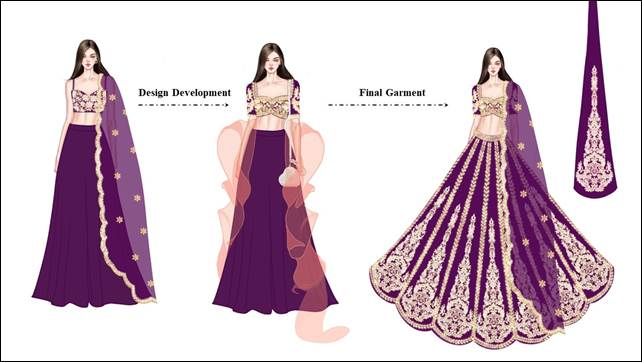
|
Figure 8 Digital Design Development – (Garment -3) |
From Figure 6, Figure 7, and Figure 8, digital garment development is
in well-defined stages. This process contains various stages, from the initial
design phase to the garment pattern creation and thorough visual analysis. Each
step ensured the accuracy and quality of the final digital garment.
Figure 9
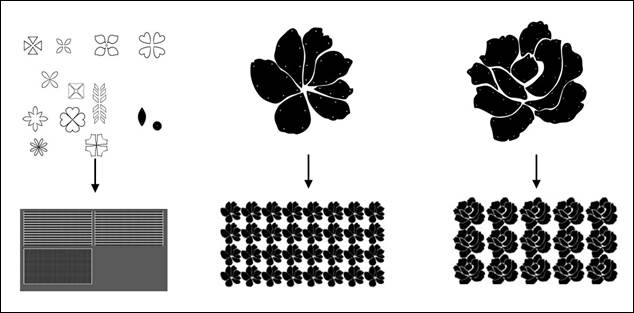
|
Figure 9 Digital Mirror Design Before Laser Cutting |
Figure 9 clearly shows that the
mirror designs underwent digital development and iteration before
laser-cutting, motifs inspired from nature and incorporating traditional and
feminine touches. This process ensured each design was meticulously crafted to
enhance its aesthetic appeal and cultural significance.
4. RESULT AND DISCUSSION
4.1. Raw material and prototype
development
For mirror work,
selected design concepts were transformed into prototypes using acrylic sheets,
georgettes, net fabric, and raw silk fabrics. Initially, laser cutting was
employed to create the mirror designs, which were applied to the fabric using aari embroidery, as shown in Figure 10. Following this process, the garments were
constructed according to the design specifications. Raw materials are sourced
from Banjara Hills, Hyderabad, Telangana.
Figure 10
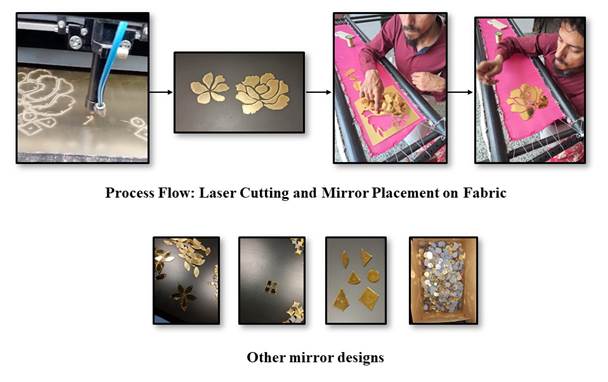
|
Figure 10 Process Flow of Mirror Cutting and Placement on Fabric |
Figure 11
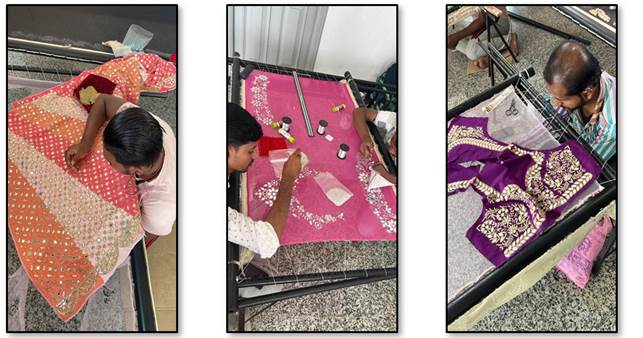
|
Figure 11 Aari Work Incorporating Mirrors |
4.2. Garment Development
Figure 12

|
Figure 12 Final Garment - 2 (Tints of Orange) |
Figure 13
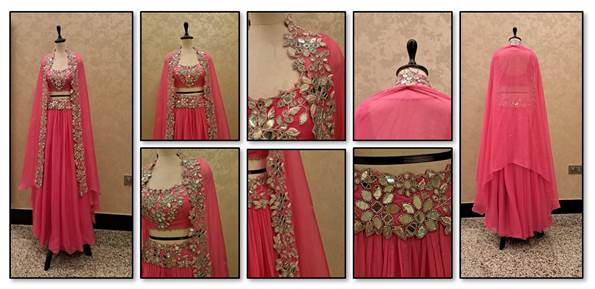
|
Figure 13 Final Garment - 1 (Salmon) |
Figure 14
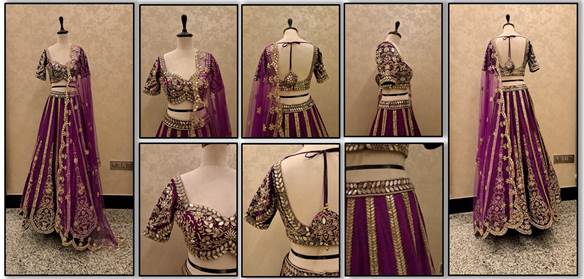
|
Figure 14 Final Garment - 3 (Mulberry) |
From Figure 11, the process begins with designing on tracing paper and transferring the
pattern onto the fabric using chalk or pencil. The selected fabric is secured
on an embroidery frame to maintain tautness for precise stitching.
"Shisha" mirrors are strategically placed based on the design layout.
Using an "aari" needle, artisans anchor the
mirrors with basic stitches, then employ intricate aari
stitches resembling chains to secure them and create elaborate patterns. Silk
threads add depth and detail, after which excess threads were trimmed.
Following a thorough inspection for imperfections, final adjustments ensure
durability. Gentle pressing smooths wrinkles and sets the stitches, giving the
embroidery a polished finish. The completed fabric is then used to create
garments that beautifully represent ethnic elegance and traditional artistry.
Each piece of garment, radiating cultural richness, showcases the exquisite
blend of aari work and mirror embroidery,
transforming the fabric into a stunning representation of timeless ethnic
fashion as shown in the Figure 12, Figure 13, and Figure 14.
4.3. Graphs on
Prototype Development
This study
presents graphs illustrating various aspects of the prototype development
process, including time, material usage, and quality assessments based on
experiential data. These visualizations provide insights into the efficiency
and effectiveness of the development stages.
Figure 15
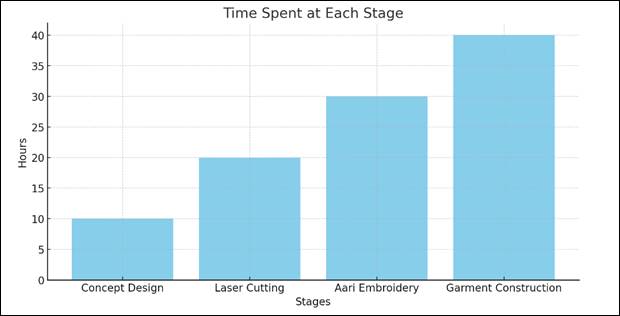
|
Figure 15 Graph - Time Spent at Each Stage |
Figure 15, This bar graph shows the hours
dedicated to each process stage. It shows that the most time-consuming stage
was Garment Construction (40 hours), and the final stage contains the cutting,
stitching, and assembly of the garment according to the design specifications.
This stage is the most time-consuming, highlighting the complexity and
attention to detail required to construct the final prototype. Furthermore,
‘Aari Embroidery’ (30 hours) is the stage where mirror designs are applied to
the fabric using aari embroidery, a traditional and
intricate technique. The time required for this stage reflects the detailed and
labour-intensive nature of the embroidery work.
Figure 16

|
Figure 16 Graph - Materials Cost at Each Stage |
Figure 16, This bar graph illustrates
the cost of materials used at each stage. The "Garment Construction"
stage has the highest price of $250 (20,865 INR), indicating the extensive use
of high-quality fabrics (such as georgettes and raw silk) and the complexity of
assembling the final prototype.
Figure 17

|
Figure 17 Graph - Quality Score at Each Stage |
Figure 17, This line graph demonstrates
the quality score achieved at each stage, rated out of 100. The quality score
improves progressively through each stage, culminating in the highest score
during the "Garment Construction" phase, indicating the successful
integration of all elements into the final product.
4.4. Findings
Thus, results provided a thorough examination of the
prototype development process, a detailed method, and techniques involved in
working with reflective materials in garment construction. This study could
include practical insights into draping, cutting, and integrating mirrors into
various fabric types (Raw silk, net fabric and georgette). The time analysis
reveals the significant effort involved in each stage, especially in garment
construction and aari embroidery. The cost analysis
highlights the considerable investment in high-quality materials necessary to
achieve the prototype's final quality. Additionally, the quality assessment
demonstrates that the combined effect of time, materials, and craftsmanship
results in an exceptional final product. Finally, the data concluded that the
efficiency and effectiveness of the development stages, emphasizing the balance
between time, cost, and quality in producing high-quality embroidered garments.
5. CONCLUSION
This study explored the secondary source, which included
an intricate process of integrating traditional mirror work into contemporary
fashion. Originating from Persia and popularized in India, mirror work is known
for its cultural and aesthetic appeal, particularly in Gujarat, Rajasthan, and
Haryana. A literature review highlighted diverse Historical significance,
Global designers and innovation in mirror work, techniques and materials used,
from framed elegance to anchor with chain stitch, and modern adaptations
involving different mirror sizes, shapes, and materials. The methodology
included a detailed literature review and digital design development, followed
by transforming these designs into prototypes using acrylic sheets, georgettes,
and raw silk fabrics. In this study, results indicated that garment
construction is the most time-consuming and costly stage, reflecting the
detailed work and high-quality materials. Limitations of this study include the
range of materials and a single design methodology that constrained design
possibilities and due to time limitation, only three prototypes were
constructed. This study underscores the complexity and creativity required to
blend traditional techniques with modern trends, demonstrating mirror work's
enduring appeal and adaptability in contemporary fashion.
Future perspectives on incorporating traditional mirror work into contemporary fashion involve exploring sustainable materials, adopting innovative design methodologies, and enhancing consumer engagement through education and cross-cultural collaborations. These strategies aim to preserve the art form while broadening its accessibility and relevance in the modern fashion industry.
CONFLICT OF INTERESTS
None.
ACKNOWLEDGMENTS
None.
REFERENCES
Chopra, Y. (2019, August 15). Everything you Need to Know About the Ancient Craft of Mirror Work. Vogue India.
Corbet, M., & Corbet, M. (2017, June 21). Shisha & Variations: How to Add the Magic of Mirrors (& More) to Your Needlework! NeedlenThread.com.
Dangor, K. (2019, November 22). Why Some Designers are Turning to the Craft of Mirror Work Season After Season. Vogue India.
Dhrutikothari. (2015, October 24). Add a Bling to your Outfits with Mirror Work. Voguetracker.
Fashion, M. (2024, February 21). What is Mirror Work? - Madhav Fashion. Madhav Fashion.
Hunar. (2021, June 29). 4 Types of Mirror Work in Apparel Designing - Hunar Online Courses. Hunar Online Courses - Blog.
Loom, T. (2022, October 17). A Dive into Mirror Work: Understanding the Art. The Loom Blog.
Mirror Work on Fabrics – 10 Simple Embroidery Designs you Could use. (2022, June 16). Unnatisilks.
Patel, N. (2023, November 10). The Magic of Mirrors: A Kaleidoscope of Embellishments - KALKI Fashion Blog. Kalki Fashion Blog – Latest Fashion Trends, Bridal Fashion, Style Tips, News and Many More.
Pedia, T. U. (2017, February 17). Mirror Work. Utsavpedia.
Soniya. (2022, May 26). Blingy Mirror Work Kurtas For Grooms-To-Be Who Love To Dazzle! - ShaadiWish. Pinterest.
The Significance of Mirror Work on Saree Belts. (2024, April 22). Sttylme.
Zoysacorrea. (2023, August 18). Mirrors and Beyond: The Allure of Embroidered Sarees with Mirror Work. Medium.
|
|
 This work is licensed under a: Creative Commons Attribution 4.0 International License
This work is licensed under a: Creative Commons Attribution 4.0 International License
© ShodhKosh 2024. All Rights Reserved.

